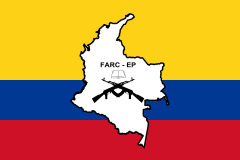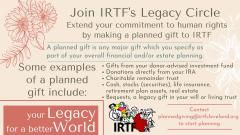
The man who wants to bring war back to Colombia wears a moustache, has dark eyes and has a 9-millimeter pistol shoved into his belt. His name is Danilo Alvizú, and he's wearing camo pants, a Che Guevara T-shirt and rubber boots. "This is a historic moment," says Alvizú. He sounds impressed by his own words.
It's the middle of a week in late August and 20 men and women have gathered before him somewhere in the oppressively humid jungle of southern Colombia, not far from the border to Ecuador. Many of the men and women standing in front of Alvizú are wearing green fatigues and black boots, just like their commander, and some are holding automatic rifles. The air is stiflingly hot and everyone is sweating profusely. Monkeys are screeching in the treetops.
Alvizú is the commander of a newly mobilized combat unit of the Revolutionary Armed Forces of Colombia (FARC), the Marxist guerrillas who laid down their weapons in Colombia three years ago after decades of fierce fighting and negotiated a peace agreement with the government. After fighting for FARC in the jungle for many years, Alvizú had even moved to the capital Bogotá and been given a job with the FARC Party, where he experienced politics up close. But he didn't like what he saw.
Colombia, Alvizú says, is a mess. Drug gangs rule the jungle, he says, and the farmers, whose interests FARC fought to defend for many decades, are still as poor as ever. He feels betrayed by a government that promised to treat the former guerrillas well and integrate them into society. Alvizú and many of his comrades are angry. They are disillusioned with peace.
If that happens, if FARC manages to reactivate its old fighters and attract new recruits, Colombia is in danger of falling back into dark times. It has become possible that a forgotten conflict -- a guerrilla war for political control, for land, money, power, resources, weapons and cocaine -- could flare up again. It would mark the rekindling of a clash that finally seemed as though it had been resolved.
Back in Business
Alvizú's fighters have gathered in Putumayo, a largely inaccessible region feared by Colombians. It is where drug baron Pablo Escobar grew cocaine back in the 1970s, and the region is ideally suited for illicit activities. There are only a few small towns and hardly any roads to go with large tracts of jungle, thousands of kilometers of river arms and fertile soil.
Alvizú agreed to give DER SPIEGEL access to his group of guerrillas. He wants the farmers of Colombia to know that FARC is back in business and intends to once again take up arms. He also wants to get the word out to the government in Bogotá, to the military and, of course, to the drug cartels. In addition to access to the fighters, he promised transparency and security, which is sorely needed in this region. In March of last year, former guerrillas murdered two journalists from Ecuador and their driver. "A misunderstanding," says Alvizú. The comment is meant to sound reassuring.
Colombia's vast jungle remains a dangerous area. For over half a century, the Colombian state battled FARC here in the longest guerrilla war in recent history. Everyone fought against everyone: the Colombian military, the right-wing paramilitaries, Mexican drug cartels involved in cocaine production, ordinary criminals and left-wing FARC fighters. The military bombed the jungle and hunted down FARC members. The guerrillas responded with terror.
Millions of people were displaced in the war and more than 250,000 died, 80 percent of them civilians. Over 27,000 people were abducted. Colombia became mired in chaos.
But there were also profiteers. The Colombian armed forces were backed by the U.S. government, which was trying to stem the cocaine epidemic in North America while at the same time supporting the American arms industry with deals in Colombia. FARC cashed in on the cultivation of coca and controlled cocaine production.
Daniel Alvizú had been a member of an armed FARC unit for 17 years when its leaders decided to begin negotiating with the government in 2012. He watched from the sidelines as Colombian President Juan Manuel Santos negotiated with leading FARC members, including Rodrigo Londoño, known as Timochenko, and Luciano Marín, known as Iván Márquez, first at meetings in Norway, then in Cuba. In the end, they forged a shaky compromise.
More Work than War
The war officially ended on June 23, 2016 with a ceasefire followed three months later by a peace treaty. Colombia's president was awarded the Nobel Peace Prize; FARC became a political party and devoted itself to policy. It looked like a victory for Colombian democracy. The EU removed FARC from its list of "terrorist groups," while the international community dropped the country off its to-do list, sat back and watched "Narcos" on Netflix and helped spark a boom in tourism for Colombia.
Even back then, Alvizú suspected that peace could sometimes be more work than war, but he wanted to give it a try anyway, he says. He found a girlfriend, applied for a directing scholarship in Cuba, which he never pursued, and finally landed a position at the FARC party headquarters in Bogotá. One of his jobs was to take photos of his former comrades who had switched to a career in politics and had begun making speeches. It was an odd experience.
Alvizú saw how Colombian politics worked, and how promises were broken. Contrary to assurances by the government, he says, former FARC rebels were persecuted and murdered, sometimes by gangs, sometimes by contract killers. He insists that only FARC respected the peace agreement, while the others did not.
Alvizú beckons to a small, wiry man in a Real Madrid jersey. "My name is William Wallace," says the man -- not his real name, but that of a Scottish freedom fighter from the 13th century. "I'm a big fan of 'Braveheart,'" Wallace says, referring to the epic Hollywood film about the famous Scottish resistance fighter.
Wallace is one of Alvizú's militiamen, as FARC calls those guerrilla fighters who seek to maintain a respectable façade. Wallace is laid-back family-man who works as a farmer. He sometimes carries his pistol in his hand, at others, he jams it into his underwear. He seems pleased to have the opportunity to show his everyday life to a German reporter over the next few days. "I won't hide anything," he promises.
Regaining a Foothold
The farmers here live almost exclusively from growing coca. The state is hardly present here in Putumayo, but when the government does intervene, it sends in soldiers to set up roadblocks and uproot coca bushes. That, of course, draws the ire of the farmers, which makes it far easier for FARC to regain a foothold here.
Wallace, the militiaman, descends a narrow path to the river, where he has his dugout canoe with an outboard engine. He fires up the engine and heads out through the night to his wooden house. His three sons, Angel, David and Alejandro, are sitting on the terrace. There are weapons on the floor and in the room on the left, a young guerillera is treating a wounded comrade who was shot two weeks earlier. The bullet entered the side of his chest and exited through his back. The woman cleans his wound and gives him a tetanus shot.
The wounded man says that the attackers belonged to the Sinaloas, a group that has named itself after the Mexican drug cartel but which allegedly has nothing to do with the original -- except, of course, that they are assassins, as he calls them.
Sitting at a table, another female comrade explains how they learned to care for and clean wounds while in the jungle, adding that "three doctors from the city were here to teach us." Unfortunately, there was a danger that they would denounce the guerrilla fighters to the army, she said. "I felt really bad about the three of them. We shot them."
She says it dispassionately, as if it were the most natural thing in the world to shoot some doctors. The message is that the new FARC is just as uncompromising as the old one. The situation is just like it was before: When FARC takes over an area, the locals have to do whatever the organization says.
Cocaine paste, the precursor of the final product, is only sold to dealers who cooperate with FARC. Whoever talks too much and endangers the guerrillas by doing so, must die. Those who can't get shake their alcohol or marijuana habit, also must die. Those who steal cocaine are killed. And deserters? No mercy for them either.
In the past, the farmers were not allowed to vote in elections, but they will be in the future now that FARC is an official party. Though many party members officially reject rearmament, Alvizú is skeptical. More than that, he says that the parliamentary representatives are secretly delighted. He knows most of them personally, after all.
Fought for Long Enough
Just behind William Wallace's stilt house is his coca field, which at just one hectare (2.5 acres), is relatively small. Some farmers have fields that cover 35 hectares, with one hectare producing slightly more than two kilos of cocaine paste every two months. FARC has currently set the gram price at 2,300 pesos, or around 60 euro cents. That adds up to over 1,200 euros ($1,335) per hectare every eight weeks -- an outstanding income in Putumayo. The people who help pick the coca leaves earn less than 10 euros a day.
Wallace says he doesn't want to return to the jungle, that he doesn't want to fight anymore. He was 16 years old when he joined FARC, and feels that he's fought long enough. As a militiaman, he is presumably one of the most important men in the entire operation, responsible for communications between the coca farmers and the guerrilla fighters. Wallace controls the finances. Without the money he brings in for the rebels, there would be no money to pay for recruits, uniforms, weapons and food. Without him, there wouldn't be a new FARC.
Wallace is proof that the rebels are gradually expanding their logistics network. And it is also becoming apparent just how fragile the 2016 peace deal actually was. Even after the agreement, the murders continued. The worst hit were those who sought to put the peace treaty into practice and implement the announced reforms -- many of which greatly displeased large landowners, ranchers and entrepreneurs. Hundreds of activists, local leaders and small farmer representatives were shot -- precisely those people that FARC had spent decades standing up for.
In Congress, where Alvizú briefly worked, the agreement became a political football. Last year, Colombia elected conservative politician Iván Duque Márquez as its new president, a man who wanted to put an end to the deal. The Márquez administration did everything it could to sabotage the work of Santos, his predecessor, with budgets being slashed or eliminated and previously agreed initiatives postponed. To date, the majority of the draft laws outlined in the peace treaty have not been passed by parliament, and some have not even been introduced.
Source: https://www.spiegel.de/international/world/farc-preparing-for-renewed-fi...
to be continued tomorrow…

